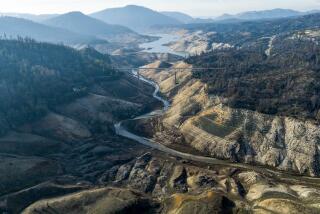Big storm could fizzle into drizzle
- Share via
Southern California’s fickle weather has done it again.
Earlier this week, the predictions were for inclement weather that could drop as much as two inches of rain on the region, giving it a much-needed soaking.
But experts from the National Weather Service now predict that this weekend’s expected rain will be no heavier than the moderate precipitation that fell last week.
“Everybody was pretty excited,” said Dessa Emch of the National Weather Service in Oxnard. “Now, we’re bummed.”
But despite that fizzle in the weekend weather, many meteorologists are saying that the promise of a wet El Nino winter remains. The Southland could get higher than average rainfall as early as January, weather service officials say.
The key, according to the federal National Oceanic and Atmospheric Administration, is the buildup of warming waters in the Pacific Ocean.
“Things are actually evolving much as anticipated and hoped for,” said Michael Halpert, lead forecaster for the agency’s Climate Predication Center in Maryland. “The favorite and most likely occurrence is wetter than average, but we certainly have not ruled out an average or below average winter.”
Kelly Redmond, regional climatologist at the Desert Research Institute in Reno, said there is a mix of curiosity and anxiety about whether El Nino conditions will translate into rain for a drought-parched region.
This week, Redmond was among a gathering of scientists at the American Geophysical Union in San Francisco, where El Nino was a major topic of discussion. Then he traveled to Las Vegas, where water managers were fretting about whether rain would replenish the Colorado River.
“They’re very interested in what the winter is going to bring,” Redmond said. “Most of us are taking a wait-and-see approach.”
Part of the reason for that is that El Nino conditions often do not translate into more rain.
“La Ninas are reliably dry,” Redmond said. “El Ninos are unreliably wet.”
And sometimes they aren’t El Ninos at all. Take 2004, when the National Oceanic and Atmospheric Administration announced the “return of El Nino” on its website.
As things turned out, 2004-2005 turned into the second wettest winter in Southern California history, but not for El Nino reasons. The rains were created by cold polar jet streams from the Gulf of Alaska.
“You won’t find many people who ascribed that winter to being an El Nino winter,” Redmond said. “Some may say it had something to do with it, but it doesn’t seem like it had very much to do with it.”
William Patzert, a meteorologist at the Jet Propulsion Laboratory in La Canada-Flintridge, said the term El Nino has come to have an outsized connotation.
“Say El Nino, and people think of houses sliding down the hillside,” Patzert said.
He said it was more likely that the upcoming winter would be on the dry side.
Patzert said that in looking at satellite images, the warming of sea-surface temperatures in the Pacific is negligible and far less widespread compared to the historic 1997-98 El Nino season, which wreaked havoc in Southern California.
“These are like two different animals,” Patzert said. “These things couldn’t even breed, they’re so different.”
Redmond said cloudiness above the warming ocean waters had failed to materialize consistently.
And the Pacific Northwest continues to be extremely wet, the opposite of what is normally seen as El Nino conditions build up in Southern California.
Then there’s the Santa Ana winds that have blown across Southern California, which usually are incompatible with El Nino conditions, Redmond said.
“The behavior of the atmosphere along the West Coast has been un-El Nino-like,” Redmond said. “It hasn’t been reading the script.”
In the end, experts said, what matters is not whether El Nino conditions technically exist, but whether the rains will come.
“We’ll take rain from anywhere,” Patzert said. “We all want more rain.”
The last time the Southland had significant rain was in late May. Humidity readings in the last month have at times been comparable to those found in Death Valley and Antarctica. The aridity has stoked wildfire conditions.
The National Weather Service had expected a strong polar storm in the region as early as Saturday. But by Thursday, experts were saying that the storm system had significantly weakened and shifted direction.
Michael Anderson, the acting California climatologist, said the verdict was still out on whether El Nino would make its presence felt in Southern California and the West.
“I’m still watching, expectantly waiting,” Anderson said. “I haven’t quite seen the signature changes that you might expect by now [with El Nino conditions]. This one is more of a head-scratcher.”
*
(BEGIN TEXT OF INFOBOX)
Maybe wet, maybe not
Although a weak El Nino is present in the central and eastern Pacific, weather experts differ on the kind of winter California can expect.
--
Wet, if traditional El Nino conditions develop
-
In most El Nino years, warm waters in the central and eastern Pacific cause the moist subtropical jet stream to shift north from Central America, leading a chain of conditions that brings rain to California.
--
Dry, if the Autumn 2006 weather pattern continues
--
Though the subtropical jet stream has been tracking north, the U.S. Southwest has stayed primarily dry since fall, with the polar jet stream funneling storms toward the Pacific Northwest.
*
Sources: Bill Patzert, Jet Propulsion Laboratory; National Weather Service
(END TEXT OF INFOBOX)
More to Read
Sign up for Essential California
The most important California stories and recommendations in your inbox every morning.
You may occasionally receive promotional content from the Los Angeles Times.










